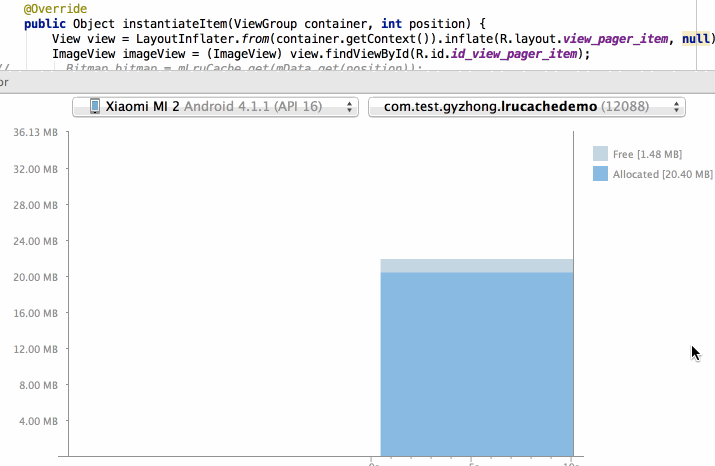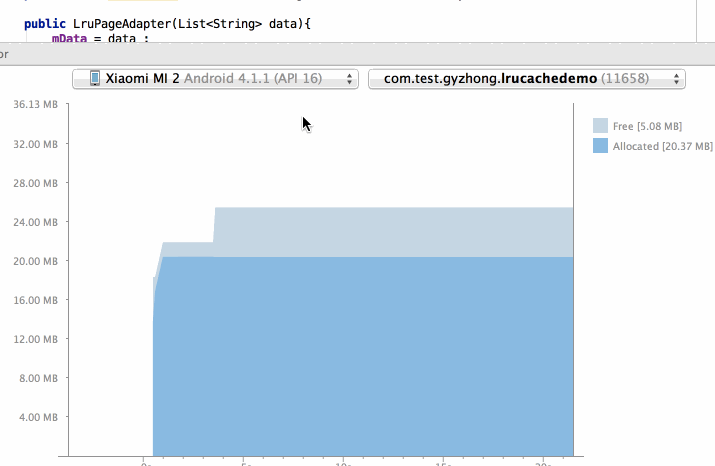編輯:關於Android編程
概念:
LruCache
什麼是LruCache?
LruCache實現原理是什麼?
這兩個問題其實可以作為一個問題來回答,知道了什麼是 LruCache,就只然而然的知道 LruCache 的實現原理;Lru的全稱是Least Recently Used ,近期最少使用的!所以我們可以推斷出 LruCache 的實現原理:把近期最少使用的數據從緩存中移除,保留使用最頻繁的數據,那具體代碼要怎麼實現呢,我們進入到源碼中看看。
LruCache源碼分析
public class LruCache<K, V> {
//緩存 map 集合,為什麼要用LinkedHashMap
//因為沒錯取了緩存值之後,都要進行排序,以確保
//下次移除的是最少使用的值
private final LinkedHashMap<K, V> map;
//當前緩存的值
private int size;
//最大值
private int maxSize;
//添加到緩存中的個數
private int putCount;
//創建的個數
private int createCount;
//被移除的個數
private int evictionCount;
//命中個數
private int hitCount;
//丟失個數
private int missCount;
//實例化 Lru,需要傳入緩存的最大值
//這個最大值可以是個數,比如對象的個數,也可以是內存的大小
//比如,最大內存只能緩存5兆
public LruCache(int maxSize) {
if (maxSize <= 0) {
throw new IllegalArgumentException("maxSize <= 0");
}
this.maxSize = maxSize;
this.map = new LinkedHashMap<K, V>(0, 0.75f, true);
}
//重置最大緩存的值
public void resize(int maxSize) {
if (maxSize <= 0) {
throw new IllegalArgumentException("maxSize <= 0");
}
synchronized (this) {
this.maxSize = maxSize;
}
trimToSize(maxSize);
}
//通過 key 獲取緩存值
public final V get(K key) {
if (key == null) {
throw new NullPointerException("key == null");
}
V mapValue;
synchronized (this) {
mapValue = map.get(key);
if (mapValue != null) {
hitCount++;
return mapValue;
}
missCount++;
}
//如果沒有,用戶可以去創建
V createdValue = create(key);
if (createdValue == null) {
return null;
}
synchronized (this) {
createCount++;
mapValue = map.put(key, createdValue);
if (mapValue != null) {
// There was a conflict so undo that last put
map.put(key, mapValue);
} else {
//緩存的大小改變
size += safeSizeOf(key, createdValue);
}
}
//這裡沒有移除,只是改變了位置
if (mapValue != null) {
entryRemoved(false, key, createdValue, mapValue);
return mapValue;
} else {
//判斷緩存是否越界
trimToSize(maxSize);
return createdValue;
}
}
//添加緩存,跟上面這個方法的 create 之後的代碼一樣的
public final V put(K key, V value) {
if (key == null || value == null) {
throw new NullPointerException("key == null || value == null");
}
V previous;
synchronized (this) {
putCount++;
size += safeSizeOf(key, value);
previous = map.put(key, value);
if (previous != null) {
size -= safeSizeOf(key, previous);
}
}
if (previous != null) {
entryRemoved(false, key, previous, value);
}
trimToSize(maxSize);
return previous;
}
//檢測緩存是否越界
private void trimToSize(int maxSize) {
while (true) {
K key;
V value;
synchronized (this) {
if (size < 0 || (map.isEmpty() && size != 0)) {
throw new IllegalStateException(getClass().getName()
+ ".sizeOf() is reporting inconsistent results!");
}
//如果沒有,則返回
if (size <= maxSize) {
break;
}
//以下代碼表示已經超出了最大范圍
Map.Entry<K, V> toEvict = null;
for (Map.Entry<K, V> entry : map.entrySet()) {
toEvict = entry;
}
if (toEvict == null) {
break;
}
//移除最後一個,也就是最少使用的緩存
key = toEvict.getKey();
value = toEvict.getValue();
map.remove(key);
size -= safeSizeOf(key, value);
evictionCount++;
}
entryRemoved(true, key, value, null);
}
}
//手動移除,用戶調用
public final V remove(K key) {
if (key == null) {
throw new NullPointerException("key == null");
}
V previous;
synchronized (this) {
previous = map.remove(key);
if (previous != null) {
size -= safeSizeOf(key, previous);
}
}
if (previous != null) {
entryRemoved(false, key, previous, null);
}
return previous;
}
//這裡用戶可以重寫它,實現數據和內存回收操作
protected void entryRemoved(boolean evicted, K key, V oldValue, V newValue) {}
protected V create(K key) {
return null;
}
private int safeSizeOf(K key, V value) {
int result = sizeOf(key, value);
if (result < 0) {
throw new IllegalStateException("Negative size: " + key + "=" + value);
}
return result;
}
//這個方法要特別注意,跟我們實例化 LruCache 的 maxSize 要呼應,怎麼做到呼應呢,比如 maxSize 的大小為緩存的個數,這裡就是 return 1就 ok,如果是內存的大小,如果5M,這個就不能是個數 了,這是應該是每個緩存 value 的 size 大小,如果是 Bitmap,這應該是 bitmap.getByteCount();
protected int sizeOf(K key, V value) {
return 1;
}
//清空緩存
public final void evictAll() {
trimToSize(-1); // -1 will evict 0-sized elements
}
public synchronized final int size() {
return size;
}
public synchronized final int maxSize() {
return maxSize;
}
public synchronized final int hitCount() {
return hitCount;
}
public synchronized final int missCount() {
return missCount;
}
public synchronized final int createCount() {
return createCount;
}
public synchronized final int putCount() {
return putCount;
}
public synchronized final int evictionCount() {
return evictionCount;
}
public synchronized final Map<K, V> snapshot() {
return new LinkedHashMap<K, V>(map);
}
}
LruCache 使用
先來看兩張內存使用的圖

圖-1

圖-2
以上內存分析圖所分析的是同一個應用的數據,唯一不同的是圖-1沒有使用 LruCache,而圖-2使用了 LruCache;可以非常明顯的看到,圖-1的內存使用明顯偏大,基本上都是在30M左右,而圖-2的內存使用情況基本上在20M左右。這就足足省了將近10M的內存!
ok,下面把實現代碼貼出來
/**
* Created by gyzhong on 15/4/5.
*/
public class LruPageAdapter extends PagerAdapter {
private List<String> mData ;
private LruCache<String,Bitmap> mLruCache ;
private int mTotalSize = (int) Runtime.getRuntime().totalMemory();
private ViewPager mViewPager ;
public LruPageAdapter(ViewPager viewPager ,List<String> data){
mData = data ;
mViewPager = viewPager ;
/*實例化LruCache*/
mLruCache = new LruCache<String,Bitmap>(mTotalSize/5){
/*當緩存大於我們設定的最大值時,會調用這個方法,我們可以用來做內存釋放操作*/
@Override
protected void entryRemoved(boolean evicted, String key, Bitmap oldValue, Bitmap newValue) {
super.entryRemoved(evicted, key, oldValue, newValue);
if (evicted && oldValue != null){
oldValue.recycle();
}
}
/*創建 bitmap*/
@Override
protected Bitmap create(String key) {
final int resId = mViewPager.getResources().getIdentifier(key,"drawable",
mViewPager.getContext().getPackageName()) ;
return BitmapFactory.decodeResource(mViewPager.getResources(),resId) ;
}
/*獲取每個 value 的大小*/
@Override
protected int sizeOf(String key, Bitmap value) {
return value.getByteCount();
}
} ;
}
@Override
public Object instantiateItem(ViewGroup container, int position) {
View view = LayoutInflater.from(container.getContext()).inflate(R.layout.view_pager_item, null) ;
ImageView imageView = (ImageView) view.findViewById(R.id.id_view_pager_item);
Bitmap bitmap = mLruCache.get(mData.get(position));
imageView.setImageBitmap(bitmap);
container.addView(view);
return view;
}
@Override
public void destroyItem(ViewGroup container, int position, Object object) {
container.removeView((View) object);
}
@Override
public int getCount() {
return mData.size();
}
@Override
public boolean isViewFromObject(View view, Object object) {
return view == object;
}
}
總結
以上就是本文的全部內容,希望本文的內容對大家的學習或者工作能帶來一定的幫助,同時也希望多多支持本站!
 Android 中實現分享和第三方登陸---以新浪微博為例
Android 中實現分享和第三方登陸---以新浪微博為例
第三方登陸和分享功能在目前大部分APP中都有,分享功能可以將自己覺得有意義的東西分享給身邊的朋友,而第三方登陸可以借助已經有巨大用戶基礎的平台(如QQ和新浪
 android6.0 Activity(二) View創建過程
android6.0 Activity(二) View創建過程
每一個Activity組件都有一個關聯的Window對象,用來描述一個應用程序窗口。每一個應用程序窗口內部又包含有一個View對象,用來描述應用程序窗口的視圖。應用程序窗
 實例詳解Android文件存儲數據方式
實例詳解Android文件存儲數據方式
總體的來講,數據存儲方式有三種:一個是文件,一個是數據庫,另一個則是網絡。下面通過本文給大家介紹Android文件存儲數據方式。1.文件存儲數據使用了Java中的IO操作
 Android 中軸時光軸
Android 中軸時光軸
ps:好久都沒有寫博客了,今天正好比較空,就來寫一篇,好像這才是第二篇,不過不要在意這些細節啦。效果圖:美女圖片都是 熊(百)掌(度)找的,如果有涉及到您的權益,請及時聯